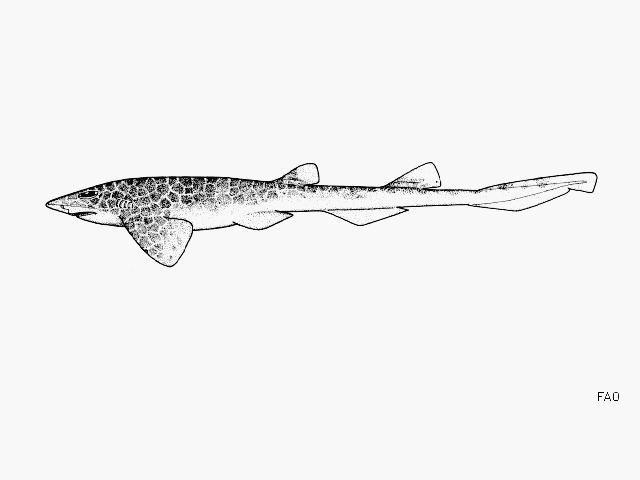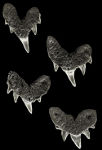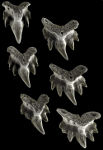Holohalaelurus regani
(Gilchrist, 1922)
Izak catshark
Classification: Elasmobranchii Carcharhiniformes Pentanchidae
Reference of the original description
Deep-sea fishes procured by the S.S. Pickle. Part 1. Report Fisheries and Marine Biological Survey, Union of South Africa, 2(3), 41–79
Deep-sea fishes procured by the S.S. Pickle. Part 1. Report Fisheries and Marine Biological Survey, Union of South Africa, 2(3), 41–79
Synonyms / new combinations and misspellings
Halaelurus regani, Scyliorhinus regani, Scyliorhinus (Halaelurus) regani, Scylliorhinus regani
Halaelurus regani, Scyliorhinus regani, Scyliorhinus (Halaelurus) regani, Scylliorhinus regani
Description :
Citation: Holohalaelurus regani (Gilchrist, 1922): In: Database of modern sharks, rays and chimaeras, www.shark-references.com, World Wide Web electronic publication, Version 12/2025
Please send your images of "Holohalaelurus regani" to info@shark-references.com

Holohalaelurus regani (Gilchrist, 1922), © FAO, www.fish-base.org

Holohalaelurus regani (Gilchrist, 1922), © FAO, www.fish-base.org
Common names
 Skaamoog,
Skaamoog,  Pejegato reticulado,
Pejegato reticulado,  Holbiche isard,
Holbiche isard,  Izak,
Izak,  Izak cat shark,
Izak cat shark,  Izak catshark,
Izak catshark,  Mottled dog-fish,
Mottled dog-fish,  Pata-roxa reticulada
Pata-roxa reticulada
 Skaamoog,
Skaamoog,  Pejegato reticulado,
Pejegato reticulado,  Holbiche isard,
Holbiche isard,  Izak,
Izak,  Izak cat shark,
Izak cat shark,  Izak catshark,
Izak catshark,  Mottled dog-fish,
Mottled dog-fish,  Pata-roxa reticulada
Pata-roxa reticulada
Short Description
A broad-headed catshark with crowded dark brown spots on a yellowish background, producing a net-like pattern of light lines; underside white with small black pores; no labial furrows [536]. Specimens less than 23 cm TL blackish with white side spots [536].
A broad-headed catshark with crowded dark brown spots on a yellowish background, producing a net-like pattern of light lines; underside white with small black pores; no labial furrows [536]. Specimens less than 23 cm TL blackish with white side spots [536].
Distribution
Indian Ocean from Durban, kwaZulu-Natal, South Africa, southwards and westwards to Cape Agulhas; westward into the Atlantic Ocean; northwards to southeast of Lüderitz, Namibia. Source: www.gbif.org
Indian Ocean from Durban, kwaZulu-Natal, South Africa, southwards and westwards to Cape Agulhas; westward into the Atlantic Ocean; northwards to southeast of Lüderitz, Namibia. Source: www.gbif.org
Biology
Oviparous, with one egg laid per oviduct at a time [536]. Embryos feed solely on yolk [733]. Found on the outer continental shelf and upper slope, on or near the bottom [517]. May occur in shallower water in the temperate region than off tropical and subtropical areas. Feeds mainly on pelagic bony fishes, also fish offal, hagfish eggs, crustaceans, and cephalopods [536].
Oviparous, with one egg laid per oviduct at a time [536]. Embryos feed solely on yolk [733]. Found on the outer continental shelf and upper slope, on or near the bottom [517]. May occur in shallower water in the temperate region than off tropical and subtropical areas. Feeds mainly on pelagic bony fishes, also fish offal, hagfish eggs, crustaceans, and cephalopods [536].
Habitat
bathydemersal; marine; depth range ? - 1075 m (Ref. 75585), usually 150 - 300 m (Ref. 75585)
bathydemersal; marine; depth range ? - 1075 m (Ref. 75585), usually 150 - 300 m (Ref. 75585)
Remarks
shark-references Species-ID=2945;
shark-references Species-ID=2945;
Parasites (arranged by Jürgen Pollerspöck)
Monogenea
Cestoda
Monogenea
- Leptomicrobothrium holohalaelure Vaughan, Christison & Hansen, 2021 [29671]
- Scyliorhinocotyle narvaezae Vaughan, Christison & Hansen, 2021 [29671]
Cestoda
- Ahamulina sp. [19536]



















